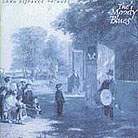March 1998
by Greg Smith
Comparison Releases: Voices in
the Sky: The Best of the Moody Blues
The
Story of the Moody Blues...Legend of a Band
Long Distance Voyager is one of those Moody Blues albums that gets fans rather polarized. Those who like the heavily symphonic sound of their earlier releases are disappointed by the synthesizer laden character of this 1981 release, suspicious that the band had sold out to gain more popularity. Apparently, it worked, because this was one of the bands most successful releases. Hit singles "The Voice" and "Gemini Dream" remain in radio rotation to this day. I personally find the influence of Patrick Moraz on keyboards to be a welcome presence. In any case, I was excited to hear what Mobile Fidelity could do with this music on CD as part of their refreshing of the Moody Blues catalog. I had two earlier collections of their music to compare with. 1984's Voices in the Sky is typical of first-generation CDs, with very compressed and unrevealing sound. The similar 1989 collection Legend of a Band is much improved. I've always considered it a very good sounding release. While I haven't made a direct comparison, I suspect the original CD release of this album sounds more like the earlier collection based on its release date. Let's start at the beginning with "The Voice". The version on the earlier collection gets off to a bad start by not including the cool synthesizer opening. It doesn't get any better as the song goes on. There are indiscriminant thumps for bass, tinny cymbals, and noise where instruments should be. The version on Legend of a Band is hugely improved. It jumps right out at you that there are two keyboard parts in the song. The bass is better, but still a little weak, and cymbals are still too tinny. After listening to the earlier versions, the MoFi disc was a relief. Low frequencies are very powerful, giving a foundation to the opening that really changes its characters for the better. Cymbals are real, and the guitars sound like actual instruments. What really comes through is how complicated the production on this song is, with layers of sound mixed together. The background details that you can barely notice on the earlier versions are clear and pervasive. "Gemini Dream" is one of those songs that it's easy to miss portions of. That's certainly the case in the 1984 release I've got. There's a tiny little soundstage, with the guitar parts sounding very odd. You hear that there's a second vocalist at times, but it's only obvious when they're singing separate parts. The 1989 version improves things quite a bit, with details like the echo on the drum skins appearing. In fact, the envelope around all the instruments are greatly enhanced, from the guitars to the keyboards. The fact that the main vocal in this song consists of two people singing together suddenly comes out. The Mobile Fidelity version really blows the imaging out, with full channel separation that gives a much more expansive presentation. The bottom-end is filled out, and the interplay between lead vocals is transformed from subtle into obvious. A substantial step up from any version of these songs I've heard before, Mobile Fidelity has produced another winner with Long Distance Voyager. Whether you prefer your Moody Blues orchestral or synthesized, you can't help but appreciate a recording that sounds this good. GO BACK TO: |
 The
Moody Blues - Long Distance Voyager
The
Moody Blues - Long Distance Voyager![[Reviewed on Gold CD]](../format/goldcd.gif)